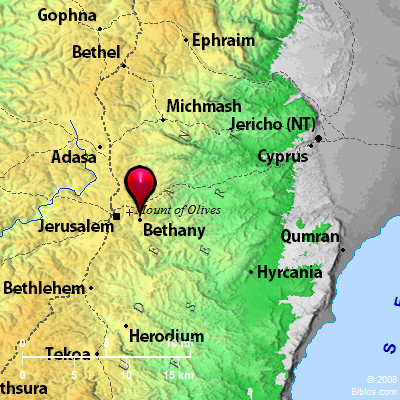Atlas  Bethany and surrounding area Maps Created using Biblemapper 3.0 Additional data from OpenBible.info You are free to use up to 50 Biblos coprighted maps (small or large) for your website or presentation. Please credit Biblos.com. Occurrences Matthew 21:17 He left them, and went out of the city to Bethany, and lodged there.Matthew 26:6 Now when Jesus was in Bethany, in the house of Simon the leper, Mark 11:1 When they drew near to Jerusalem, to Bethsphage and Bethany, at the Mount of Olives, he sent two of his disciples, Mark 11:11 Jesus entered into the temple in Jerusalem. When he had looked around at everything, it being now evening, he went out to Bethany with the twelve. Mark 11:12 The next day, when they had come out from Bethany, he was hungry. Mark 14:3 While he was at Bethany, in the house of Simon the leper, as he sat at the table, a woman came having an alabaster jar of ointment of pure nard-very costly. She broke the jar, and poured it over his head. Luke 19:29 It happened, when he drew near to Bethsphage and Bethany, at the mountain that is called Olivet, he sent two of his disciples, Luke 24:50 He led them out as far as Bethany, and he lifted up his hands, and blessed them. John 11:1 Now a certain man was sick, Lazarus from Bethany, of the village of Mary and her sister, Martha. The Acts of the Apostles John 11:18 Now Bethany was near Jerusalem, about fifteen stadia away. John 12:1 Then six days before the Passover, Jesus came to Bethany, where Lazarus was, who had been dead, whom he raised from the dead. Encyclopedia BETHANYbeth'-a-ni (Bethania): BETH'ANY is supposed to mean house of poverty, in allusion to its location near the desert, or wilderness, of Judea. It may also mean house of dates. It is a small village of about 20 rude houses, now called el Aziriyeh which means the place of Lazarus, one mile due e. of the s. wall of Jerusalem, but by the road nearly two miles from St. Stephen's gate. Strong's Greek G963: Bthania"house of affliction" or "house of dates," Bethany, the name of two cities in Palestine |



